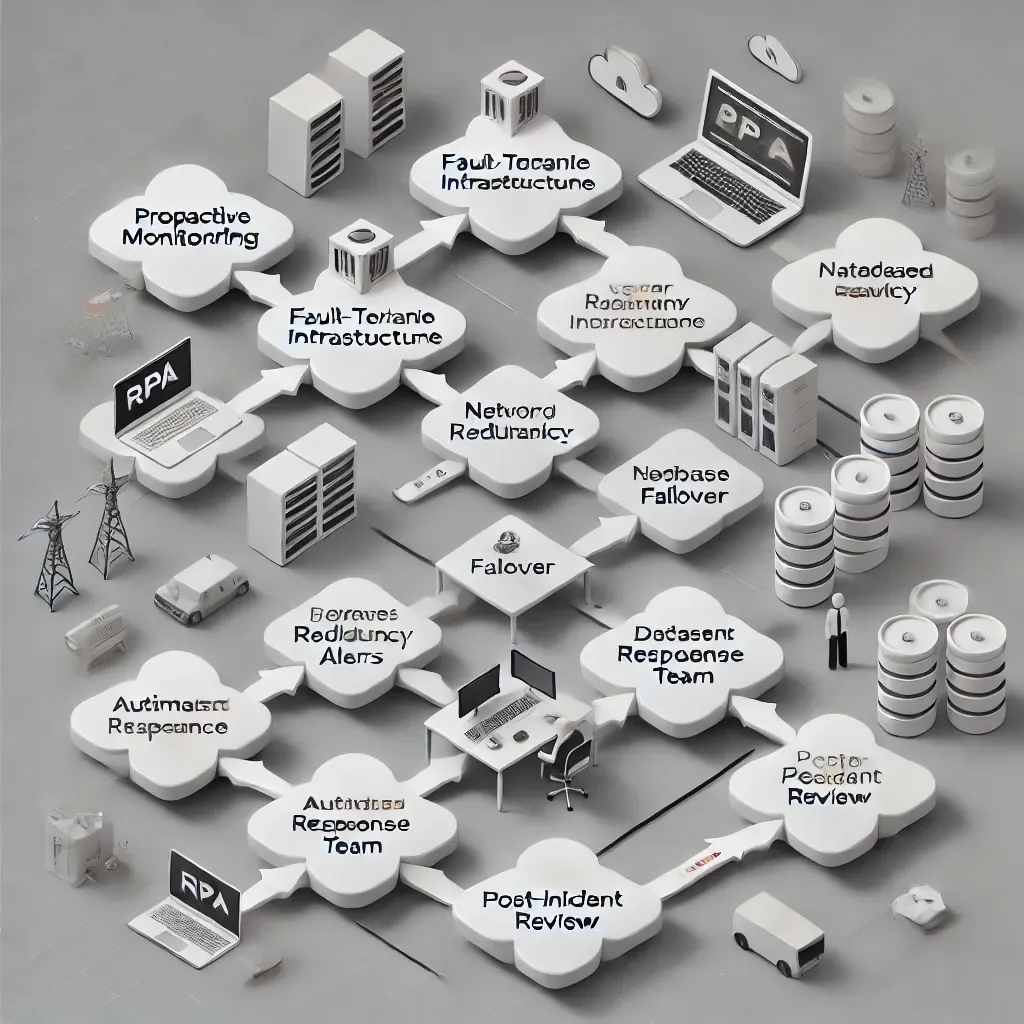Robotic Process Automation (RPA) can greatly enhance the efficiency of any organization. However, like all digital systems, it relies heavily on infrastructure. When the infrastructure fails, RPA processes can also fail. Therefore, it is crucial to know how to handle such failures swiftly to minimize disruption. Here, we will explore how to manage infrastructure failures in RPA-enabled environments.
Table of Contents
Understanding Infrastructure Failures
First, it’s important to understand what “infrastructure” means in an RPA context. Infrastructure refers to the hardware, network, and software systems that support the RPA processes. Failures in these areas can cause RPA workflows to stop. There are various types of infrastructure failures:
- Server failures: These occur when servers hosting RPA platforms go down.
- Network failures: Loss of network connectivity can interrupt RPA operations.
- Database failures: If databases storing process information fail, RPA bots may be unable to execute workflows.
- Software crashes: Any application that supports the RPA environment, including the bots themselves, can crash.
To manage these risks, it’s critical to establish a clear response strategy. Let’s explore these strategies step by step.

Proactive Monitoring and Alerts
To avoid infrastructure failures, start with proactive monitoring. You should implement monitoring systems that keep track of key infrastructure components. These systems check server health, database status, network performance, and application uptime.
Setting Up Alerts
Once monitoring is in place, set up real-time alerts. When any critical infrastructure issue is detected, alerts notify the relevant team members. This ensures that you can respond to the failure before it affects the RPA process. Most monitoring platforms offer email, SMS, and dashboard alerts.
The diagram above shows how a monitoring system can detect issues before they cause major problems. For instance, if a server’s CPU usage spikes, the system alerts the team, enabling them to resolve the issue quickly.
Fault-Tolerant Infrastructure
The best way to reduce the impact of infrastructure failure is to make it fault-tolerant. This means building redundancy into the system. Redundancy involves having backup resources that take over if the primary ones fail.
Server Redundancy
Server redundancy involves setting up multiple servers. When one server fails, the load shifts to another server, ensuring that RPA bots can continue running. Cloud infrastructure makes server redundancy easy to implement because you can quickly deploy and manage multiple servers.
Network Redundancy
Similar to servers, network redundancy ensures continuous connectivity. If the primary network connection fails, a secondary one takes over. Virtual Private Networks (VPNs) and Software Defined Networks (SDNs) make this process seamless.
Database Replication
Database replication ensures that data remains accessible. If one database goes down, another synchronized version is ready to take over. This ensures that RPA processes can continue accessing the data they need.
By building fault-tolerance into your RPA infrastructure, you minimize the chance of an infrastructure failure causing downtime.
Automating Failover Processes
In RPA-enabled environments, automation is a natural fit for handling infrastructure failures. Automating failover processes means the system detects a failure and immediately shifts to backup resources without manual intervention.
Implementing Failover
For instance, if a server goes down, the RPA system automatically shifts to the secondary server. The bots continue running without missing a beat. This automation reduces downtime to a few seconds, minimizing the business impact.
Here’s how you can automate the failover process:
- Identify critical systems: Determine which systems need failover, such as RPA bots, databases, and applications.
- Set up failover policies: Define when and how the system should switch to backups.
- Test regularly: Ensure that failover systems work by testing them periodically.
By automating failovers, you reduce dependency on human intervention and can keep processes running smoothly.
Backups and Disaster Recovery
Even with fault-tolerant systems, failures can happen. Therefore, having a solid disaster recovery plan is essential. The key elements of disaster recovery include data backups and recovery processes.
Regular Data Backups
Schedule regular backups of all critical data. This includes process logs, configuration files, and database entries. Store backups in multiple locations, including offsite or in the cloud. In case of an infrastructure failure, you can restore data quickly.
Disaster Recovery Testing
Test your disaster recovery processes periodically. Simulate different failure scenarios and ensure that your team knows how to restore the system. The faster you can recover, the less impact infrastructure failures will have on your RPA processes.
Scalability Considerations
Another aspect of handling infrastructure failures is ensuring scalability. As your RPA processes grow, your infrastructure must scale with them. Failing to plan for this can lead to infrastructure bottlenecks, resulting in failures.
Horizontal and Vertical Scaling
There are two main ways to scale:
- Horizontal scaling: Add more servers or instances to handle the increased load.
- Vertical scaling: Increase the capacity of your existing servers by upgrading CPU, memory, and storage.
Most modern RPA platforms offer automatic scaling features. When more resources are needed, the platform adds them automatically. This prevents infrastructure overload, which could lead to failures.
Incident Response Team
When failures do happen, having an incident response team in place is crucial. This team should be well-trained in handling RPA infrastructure failures. They need to know how to diagnose issues and resolve them quickly.
Key Steps for the Incident Response Team
- Identify the root cause: Quickly determine whether the failure is due to hardware, network, software, or another issue.
- Communicate: Ensure that all relevant stakeholders know about the issue and its impact on the RPA processes.
- Resolve the issue: Take corrective actions based on the failure type.
- Post-incident review: After resolving the issue, perform a review to understand what went wrong and how to prevent it in the future.
An effective incident response team can make a huge difference in reducing the impact of infrastructure failures.
Continuous Improvement
Finally, managing infrastructure failures is an ongoing process. It is essential to continuously review and improve your systems. After every failure, conduct a post-mortem analysis. Look for the root causes and identify areas for improvement.
Key Improvement Strategies
- Update systems regularly: Keep your infrastructure up-to-date with the latest patches and upgrades.
- Review failover policies: Ensure that your failover systems are still relevant as your infrastructure evolves.
- Test disaster recovery plans: Regular testing ensures that your team is prepared for any scenario.
By focusing on continuous improvement, you ensure that your RPA infrastructure becomes more resilient over time.
Conclusion
Handling infrastructure failures in RPA-enabled environments requires a proactive approach. From monitoring and fault-tolerant systems to automated failover and disaster recovery, there are multiple strategies you can employ. By implementing these strategies, you reduce the likelihood of failure and ensure that RPA processes run smoothly, even when unexpected issues arise. Moreover, focusing on continuous improvement will make your RPA infrastructure more robust and reliable in the long term.








